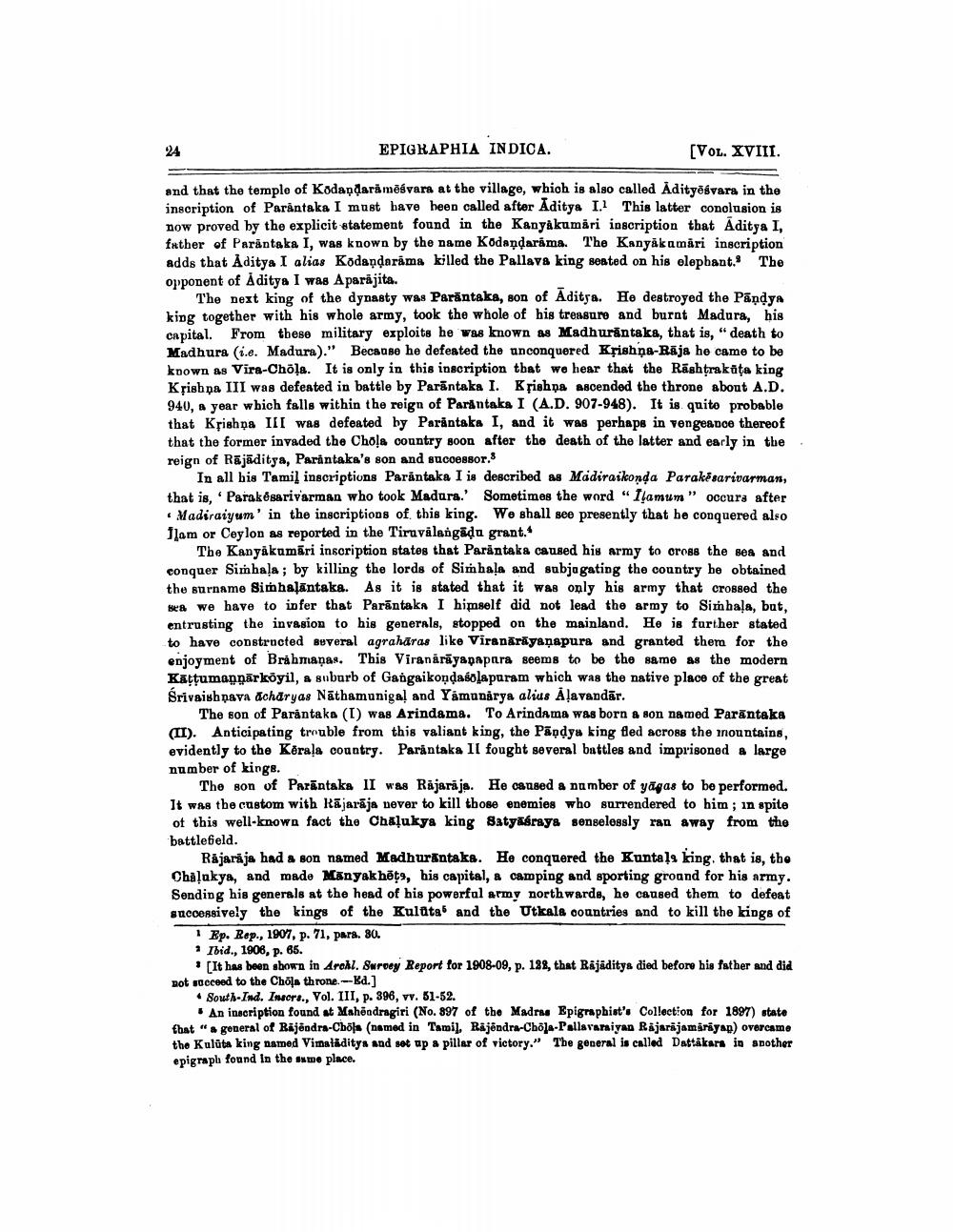________________
24
EPIGRAPHIA INDICA.
(VOL. XVIII.
and that the temple of Kodaņdaråmēśvara at the village, which is also called Adityēsvara in the inscription of Parantaka I must have been called after Aditya I. This latter conclusion is now proved by the explicit statement found in the Kanyakumari inscription that Aditya I, father of Parantaka I, was known by the name Kodaņdarāma. The Kanyakamāri inscription adds that Aditya I alias Kodaņdarama killed the Pallava king seated on his elephant. The opponent of Aditya I was Aparajita.
The next king of the dynasty was Parāntaka, son of Aditya. Ho destroyed the Pandya king together with his whole army, took the whole of his treasure and burnt Madura, his capital. From these military exploits he was known as Madhurāntaka, that is, "death to Madhura (i.e. Madura)." Because he defeated the unconquered Krishiņa-Raja ho came to be known as Vira-Chöļa. It is only in this inscription that we hear that the Rashtrakāta king Krishna III was defeated in battle by Parāntaka I. Krishna ascended the throne about A.D. 940, a year which falls within the reign of Parantaka I (A.D. 907-948). It is quite probable that Krishna III was defeated by Parantaka I, and it was perhaps in vengeance thereof that the former invaded the Chola country soon after the death of the latter and early in the reign of Rajaditya, Parantaka's son and successor.
In all his Tamil inscriptions Parantaka I is described as Madiraikonda Parakesarivarman, that is, .Parakosarivarman who took Madura.' Sometimes the word “flamum" occurs after
Madiraiyum' in the inscriptions of this king. We shall see presently that he conquered also flam or Ceylon as reported in the Tiruvalangāda grant.*
The Kanyakumāri inscription states that Parantaka caused his army to cross the sea and conquer Simhala ; by killing the lords of Simhala and subjagating the country be obtained the surname Simhalántaka. As it is stated that it was only his army that crossed the
A we have to infer that Parāntaka I himself did not lead the army to Sinhala, bat, entrusting the invasion to his generals, stopped on the mainland. He is further stated to have constructed several agrahāras like Viranārāyanapura and granted there for the enjoyment of Brahmaņas. This Viranårāyapapara seems to be the same as the modern Kattumapņārköyil, a suburb of Gangaikondasolapuram which was the native place of the great Árivaishnava acharyas Nāthamuniga! and Yamunarya alius Aļavandār.
The son of Parantaka (I) was Arindama. To Arindama was born & son named Parāntaka (II). Anticipating trouble from this valiant king, the Pāṇdya king fled across the mountains, evidently to the Kerala country. Parantaka II fought several battles and imprisoned a large number of kinge.
The son of Parantaka II was Rājarājs. He caused a number of yāgas to be performed. It was the custom with Rājarāja never to kill those enemies who surrendered to him ; in spite of this well-known fact the Chalukya king Satyasraya senselessly ran away from the battlefield.
Rajaraja had a son named Madhurāntaka. He conquered the Kuntala king, that is, the Chalukya, and made Manyak hēts, his capital, a camping and sporting ground for his army. Sending his generals at the head of his powerfal army northwarde, he caused them to defeat guccessively the kings of the Kulata and the Utkals countries and to kill the kings of
1 Ep. Rep., 1907, p. 71, para. 80. * Ibid., 1906, p. 65.
+ [It has been shown in Arokl. Suroey Report for 1908-09, p. 188, that Räjāditys died before his father and did Rot socceed to the Chola throne. --Ed.]
• South-Ind. Inscrs., Vol. III, p. 396, vv. 51-52.
* An inscription found at Mahendragiri (No. 897 of the Madras Epigraphist's Collection for 1897) state that " a general of Rajendra-Cbols (named in Tamil, Rajendra-Chola-Pallavaraiyan Rajarajamárāyap) overcame the Kulūta king named Vimaliditys and set up a pillar of victory." The general is called Dattakars in another epigraph found in the same place.




